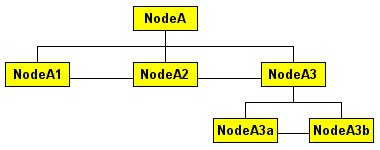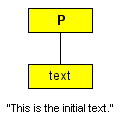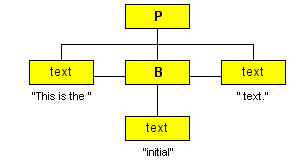The Document Tree
http://www.brainjar.com/dhtml/intro/default3.asp
Nodes

The Node object provides several properties to reflect this structure and allow you to traverse the tree. Here are some relationships using the example above:
- NodeA
.firstChild= NodeA1 - NodeA
.lastChild= NodeA3 - NodeA
.childNodes.length=3 - NodeA
.childNodes[0]= NodeA1 - NodeA
.childNodes[1]= NodeA2 - NodeA
.childNodes[2]= NodeA3 - NodeA1
.parentNode= NodeA - NodeA1
.nextSibling= NodeA2 - NodeA3
.prevSibling= NodeA2 - NodeA3
.nextSibling=null - NodeA
.lastChild.firstChild= NodeA3a - NodeA3b
.parentNode.parentNode= NodeA
The Node interface also provides methods for dynamically adding, updating and removing nodes such as:
insertBefore()replaceChild()removeChild()appendChild()cloneNode()
This interface provides methods for accessing and creating other nodes in the document tree. Some methods are:
getElementById()getElementsByTagName()createElement()createAttribute()createTextNode()
Traversing the Document Tree
Consider the following:
<html>
<head>
<title></title>
</head>
<body><p>This is a sample paragraph.</p></body>
</html>
and this code:
alert(document.documentElement.lastChild.firstChild.tagName);
which would display "P", the name of the tag represented by that node. The code breaks down as follows:
document.documentElement- gives the page's HTML tag..lastChild- gives the BODY tag..firstChild- gives the first element in the BODY..tagName- gives that element's tag name, "P" in this case.
Accessing Elements Directly
<p id="myParagraph">This is a sample paragraph.</p>
...
alert(document.getElementById("myParagraph").tagName);
-----------------
var nodeList = document.getElementsByTagName("A");
for (var i = 0; i < nodeList.length; i++)
nodeList[i].style.color = "#ff0000";
Attributes
<p id="sample1" align="left">Text in a paragraph element.</p>
... code for the links ...
document.getElementById('sample1').setAttribute('align', 'left');
document.getElementById('sample1').setAttribute('align', 'right');
Text Nodes
<p id="sample1">This is the initial text.</p>
... code for the links ...
document.getElementById('sample1').firstChild.nodeValue =
'Once upon a time...';
document.getElementById('sample1').firstChild.nodeValue =
'...in a galaxy far, far away';

--------------------------
<p id="sample2">This is the <b>initial</b> text.</p>





